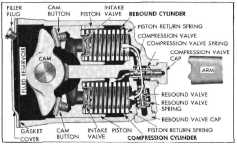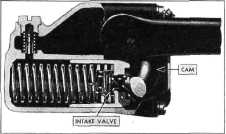1942 - 1947 CHEVROLET SHOP MANUAL
Section 2 - Frame
|
|
|||
|
2-7 |
|||
|
|
|||
|
pressure
allows the piston spring to force the piston outward, creating a partial vacuum
behind the piston. The partial vacuum causes the intake valve under the head of the piston to open,
permitting the fluid to flow under the piston head and fill
the piston chamber, Fig.
7. |
parallel cylinder type. Fig. 9 is
a cross section view of this type unit. |
||
 |
|||
 |
|||
|
Fig. 9—Cross-Section of
Parallel Double-Acting Shock Absorber Action |
|||
|
|
|||
|
Fig. 7—Shock Absorber Action When Car Strikes a
Bump
As the
wheels pass over the bump, the car springs rebound and the car frame moves
upward, carrying the shock
absorber with it. This causes the shock absorber arm to move downward,
applying cam pressure on
the piston. The cam forces the
piston into the cylinder, closing the intake valve. The oil, trapped in the cylinder,
forces the |
Inside the
body and pressed on the camshaft is a
double cam, one end of which bears on one piston during compression, and the opposite end on
the other piston during rebound. A return spring is provided under each piston to keep the
latter firmly against the cams.
An intake valve is provided in each piston whose function is to
permit fluid to be replenished
when lost by piston leakage as
the cylinders are filled under pressure from valve discharge of the
opposite cylinder. The fluid reservoir is in the area around the
cam.
The two
cylinders are identical and the fluid discharge takes place from one cylinder to
the other under operating
conditions through the relief valves located in the drilled passageways
in the shock absorber body. One
of the relief valves controls the rebound resistance while the other
controls the compression
resistance. Both of these valves may be reached after removing the valve
plugs or nuts. Removing the filler plug permits filling or adding fluid. |
||
 |
|||
|
|
|||
|
Fig. 8—Shock Absorber Action in Controlling Rebound of
Car
Spring
relief
valve off its seat and passes through a restricted orifice into the
reservoir. This action, Fig. 8, slows
up the rebound of the car springs.
The type
single-acting shock absorber shown in Fig. 6, with a separately mounted
intake valve and relief valve, is
used on the front and rear of the 1/2, 3/4 and 3/4-ton
special and on the front only of the 3/4-ton long Wheelbase panel
truck.
PARALLEL CYLINDER DOUBLE-ACTING
SHOCK
ABSORBERS
The
double-acting shock absorbers used on the front and rear of passenger cars are known
as the |
 |
||
|
Fig. 10—Passenger Car Front Shock Absorber
Mounting |
|||
|
|
|||